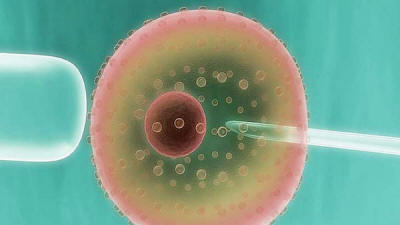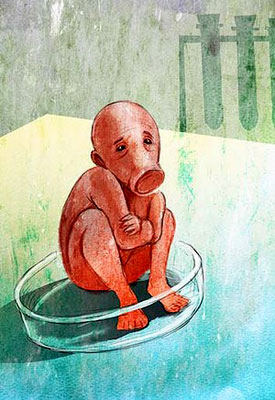|
from BrisbaneTimes Website
... altering humans
may be a safer option than trying to alter the planet.
Climate change is a problem that requires thinking - sometimes uncomfortably - outside
the accepted status quo.
Human-induced climate change is one of the biggest problems that we face today. Millions could suffer hunger, water shortages, diseases and coastal flooding because of climate change.
The latest science suggests that we may
be near or even beyond the point of no return.
However, geoengineering seems too risky.
Many of the technologies involved have
never been employed on such a large scale, which means that we could
be endangering ourselves or future generations. Indeed, spraying
sulfate aerosols could destroy the ozone layer and iron
fertilization could promote toxic planktons and destroy all forms of
marine life.
One might be able to use
pre-implantation genetic diagnosis to
select shorter children.
I propose that we consider another solution to the problem of climate change that has not been considered before and that is potentially less risky than geoengineering.
Elsewhere my colleagues and I have called this solution ''human engineering''.
It involves the biomedical modification of humans to make us better at mitigating, and adapting to the effects of, climate change.
Before I explain the proposal, let me make clear that human engineering is intended to be a voluntary activity - possibly supported by incentives such as tax breaks or sponsored healthcare - rather than a coerced, mandatory activity.
My colleagues and I are positively
against any form of coercion of the sort that the Nazis perpetrated
in the past (segregation, sterilization and genocide).
Also, this proposal is intended for
those who believe that climate change is a real problem, and who, as
a result, are willing to take seriously geoengineering. Someone who
doesn't believe that climate change is a real problem is likely to
think that encouraging people to recycle more is an overreaction to
climate change.
This is an attempt to encourage ''outside the box'' thinking vis-a-vis a seemingly intractable problem.
Here are four examples of human
engineering that seem feasible to implement in the near future
and potentially have broad appeal.
Close to 9 per cent of human CO2
emissions are due to deforestation for expansion of pastures, 65 per
cent of nitrous oxide is due to manure and 37 per cent of methane
comes directly or indirectly from livestock.
Indeed, even a minor (21 per cent to 24
per cent) reduction of red meat consumption would achieve the same
reduction in emissions as the total localization of food production;
that is, having zero ''food miles''.
However, there are others who may be
willing to give up eating red meat, but they lack the motivation or
willpower to do so. After all, many people find the taste of red
meat simply irresistible, which may explain why many vegetarian
restaurants offer dishes that taste like meat.
The immune system would then become primed to react to them, and henceforth eating ''eco-unfriendly'' food would induce unpleasant experiences.
Even if the effects would not last a lifetime, the learning effect is likely to persist for a long time. A potentially safe and practical way of inducing such intolerance may be to produce ''meat'' patches - akin to nicotine patches. People can then wear these patches before they eat to curb their enthusiasm for red meat.
To ensure that these patches have the
broadest appeal, we can produce patches that just target animals
that contribute the most to greenhouse gas emissions.
We require a certain amount of food and nutrients to maintain each kilogram of body mass. The larger one is, the more food and energy one requires. Larger people also consume more energy in less obvious ways.
A car uses more fuel each kilometer to
carry a heavier person than a lighter person; more fabric is needed
to clothe larger than smaller people; heavier people wear out shoes,
carpets and furniture more quickly than lighter people.
Reducing the average height in the US by
just 15 centimeters would mean a mass reduction of 23 per cent for
men and 25 per cent for women, with a corresponding reduction of the
metabolic rate (15 per cent/18 per cent).
Height is determined partly by genetic factors and partly through diet and stressors.
The last two methods are controversial as they involve making irreversible choices for one's children. But parents are permitted to give hormone treatments to their children, who are otherwise perfectly healthy, so that, for example, a daughter predicted to be 195 centimeters tall could instead be 183 centimeters tall.
On what grounds then should we forbid other parents who want to give hormone treatments to their children so that their children could be 152 centimeters tall instead of 165 centimeters tall?
It might be thought that in the case of the former, the daughters would later appreciate and consent to the parents' decision.
But if climate change would seriously affect the well-being of millions of people including one's children, then these children may also later appreciate and consent to the parents' decision. It is also worth remembering how fluid human traits - such as height - are.
A hundred years ago people were much
shorter on average, and there was nothing wrong with them medically.
We should be wary of the idea that there is an optimal height,
namely, the average height in our society today, since this may
simply reflect a status-quo bias.
There are, of course, many available
methods of curbing birth rates, such as the use of contraception.
But there is strong evidence that birth rates decline as more women
receive adequate access to education.
Hence, another possible human
engineering solution is to use cognition enhancements, such as
Ritalin and
Modafinil, to achieve lower
birth rates.
Even if the direct cognitive effect on
fertility is minor, cognition enhancements may help increase the
ability of people to educate themselves, which would then affect
fertility and, indirectly, climate change.
But if people were generally more
willing to act as a group, we may be able to enjoy the sort of
benefits that arise only when large numbers of people act together.
For example, test subjects given the prosocial hormone oxytocin were more willing to share money with strangers and to behave in a more trustworthy way. Also, a noradrenaline reuptake inhibitor increased social engagement and co-operation with a reduction in self-focus.
Furthermore, oxytocin appears to improve
the capacity to read other people's emotional state, which is a key
capacity for empathy. This suggests that interventions affecting the
sensitivity in these neural systems could increase the willingness
to co-operate with social rules or goals.
Instead, there might be someone who
wants to do the right thing, but owing to a weakness of will,
cannot get himself to do the right thing. Having the option to use
pharmacological means to increase altruism and empathy may allow
this person voluntarily to overcome his weakness of will and enable
him to do the right thing.
It should be clear that human engineering is less risky than geoengineering. In addition to the fact that much of the technology involved in human engineering - such as pre-implantation genetic diagnosis and oxytocin - is already safely available for other uses, human engineering applies at the level of individual humans.
This means that we can better manage
these risks than those imposed by something such as geoengineering,
which takes place on a global, scale.
But suppose that the relevant issue is some kind of fixed allocation of greenhouse gas emissions for each family.
If so, given fixed allocations of
greenhouse gas emissions, human engineering could give families the
choice between having one large child, two medium-sized children or
three small children. Human engineering seems more liberty enhancing
than a policy that says you can have only one or two children.
Given the enormous risks associated with
changing the environment, we should take seriously the idea that
we may need to change ourselves.
|



